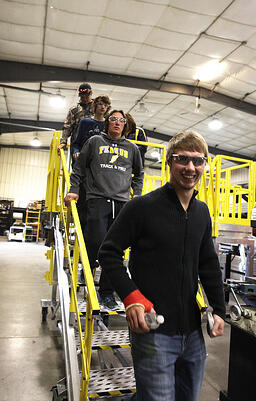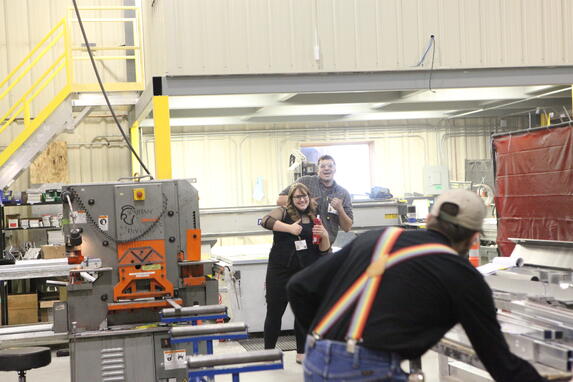3 Ways to Close the Skills Gap with Today's Workforce
You may have heard that US manufacturers are facing a shortage of skilled workers — a shortage so severe that in 2011, 600,000 jobs went unfilled. What's the big deal, you ask? Plenty of kids graduate from high school and college each year. Surely they'll fill that gap.
Actually, they won't unless we do something about it. As a 2011 report by Deloitte and The Manufacturing Institute discovered,
- with Baby Boomers approaching retirement, 50% of the current manufacturing workforce will be putting down their tools and picking up their margaritas within the next 10-15 years!
- Despite the fact that 70% of Americans view manufacturing as the most important industry for a strong economy and national defense, and despite the fact that 90% of all manufacturing jobs have medical benefits with average wages upwards of $70K...
- Youth between 18-24 ranked manufacturing as only the 5th industry in which they would choose to begin their careers, trailing behind technology, energy, healthcare, and communications, and leading only financial services and retail.
With the need for workers so great, and the benefits of working in manufacturing so apparent, what are the steps we can take to bulk up the skilled workforce in our industry?
1. Remind Kids That Manufacturing Is "Sexy"
Honestly, our young workforce is idling in the stubborn misperception that manufacturing is stuck in the early 1900s with dangerous working conditions, dark buildings and dirty environments.
But as Time Magazine pointed out in an article last year, "Today’s U.S. factories aren’t the noisy places where your grandfather knocked in four bolts a minute for eight hours a day. Dungarees and lunch pails are out; computer skills and specialized training are in, since the new made-in-America economics is centered largely on cutting-edge technologies."

Manufacturing companies are defined by creating new products either directly from raw materials or components. This means bakeries, candy stores, and custom tailors are all part of manufacturing. You can be a welder, sewer, medical appliance technician, jeweler, dental laboratory technician or water treatment worker among many, many other positions. Montana's manufacturing positions alone run the gamut from Spika's need for machinists for maintenance platforms to Red Oxx's sewers of sturdy luggage to Great Harvest's bread bakers.
A variety of factors has brought us to the point where we're facing a shortage of workers with technical skills. But with the US holding the title as the leading manufacturer of the world, we need to encourage people who want hands-on, innovative positions that don't require them to sit at a computer all day to come into manufacturing. Manufacturing is, above all, a skill and in some instances, an art. And it's sexy.
2. Reach Out To Kids and Women
It's obvious that the way to capture the mind of a person is to introduce them to an idea at an early age. Our nation needs to focus energy on fostering the talents of hands-on students from the time they begin school. By identifying their interest early on in more technical industries, we can filter them into robotics clubs or welding clubs as soon as they're in middle school or junior high. Manufacturers need to be promoting manufacturing through plant tours and scholarships. We need to encourage the kids who want to work with their hands to pursue a technical diploma from high school instead of the standard college-prep diploma (assuming the high school has a technical diploma track...many do not). We need to encourage our educators to build both high school and college curriculums to certify students in different skills so that when they enter the workforce, they have some marketable skill — particularly a skill that the Baby Boomers are vacating — such as machining, operating, craft working (such as welding), distributing and other technical positions.

Additionally, efforts to promote women in manufacturing need to be doubled, if not quadrupled. How many women are there in our communities that need jobs after their kids graduate high school? How many women enjoy working with their hands but are stuck behind a computer all day? Many of these women resort to receptionist positions or fast-food jobs — jobs that oftentimes are not challenging and offer little to no advancement opportunities — because they don't know where else their skills can be utilized. Little known fact: Women are actually great assemblers and welders because women pay close attention to detail. They oftentimes understand communication better. If they were equipped with local continuing ed classes or certificate programs that could gain them the basic skills needed to cut metal or assemble and fit a product together, they could easily take over the manufacturing industry.
3. Change Technical Degrees Into Stackable Certifications
Oftentimes US high schools default to putting their students on the path of college prep diplomas, which means they require a certain number of credits for math, science, history, English, etc. in order to be prepared to enter a 4-year degree program. But this program is catering to a demographic that learns best in a lecture-based curriculum with academia as the focus.
The demographic of students that can rewire their light switches at home but receive Cs and Ds in school is being grossly ignored. And high schools are churning out many of these hands-on students who will go to college for a year then drop out because they 1) still hate history class and just aren't wired for academia, 2) aren't satisfied with the prospects of getting a degree just to sit behind a computer at a desk job, or 3) don't see the point in earning a 4-year degree since 46% of workers who graduated from college in the past two years say they are underemployed and working in jobs that do not require their college degrees.
We need to train our young workforce quickly and without unnecessary academic classes. While earning a "well-rounded education" is admirable and certainly helpful in some situations, people who attend technical colleges are looking for technical skills. Hands-on experience. Certification in specific trades. They need to be focusing all their effort and time into gaining the knowledge required to perform specific duties. Get rid of the 1-year certificate or 2-year diploma programs. Start teaching students through stackable credits — classes offered to students to quickly achieve an industry certification at a community college and oftentimes leads directly to employment. These classes don't last a quarter or a semester. You don't have to take biology or Spanish history to earn the certificate. Above all, the students become hugely attractive and marketable in an industry that is desperate for skilled workers.
What is Being Done to Curb the Skills Gap?
Some states and schools are already taking matters into their own hands. San Antonio manufacturers, for example, partnered with the Alamo Community Colleges to introduce high-school juniors and seniors to manufacturing careers and higher education by completing an industry-driven curriculum to develop work ready skills in manufacturing. The dual-credit program incorporates classroom instruction with hands-on learning in a state-of-the-art facility and allows participating students to graduate high school with up to 35 credits, a National Career Readiness Certificate (NCRC), and the Production Technician Certification from the Manufacturing Skills Standards Council (MSSC).
The government also has its own incentive in the form of SWAMMEI, a $24.9 million grant project for Montana funded by the U.S. Department of Labor (USDOL). Its aim is to accomplish a very specific set of objectives, among them being the integration of industry-recognized credentials (e.g. American Welding Society) into colleges’ traditional curriculum.
With the evolution of technology and the changing workforce in the manufacturing industry, there will plenty of new and changing positions in which the skilled workforce will need to adapt. Manufacturing itself is adapting to its own ever-changing landscape — every year brings new challenges and opportunities. And it needs people to step up.
Want to know more about jobs in manufacturing?



